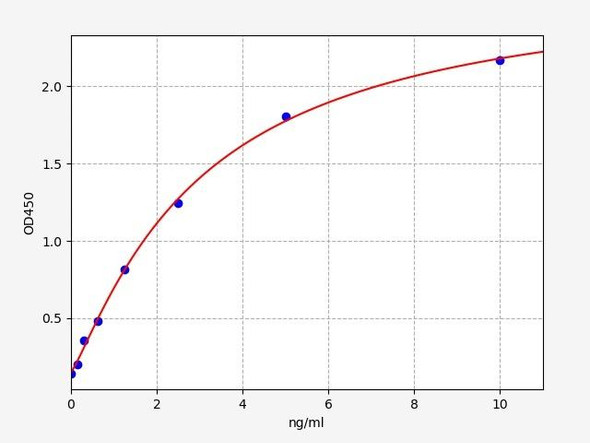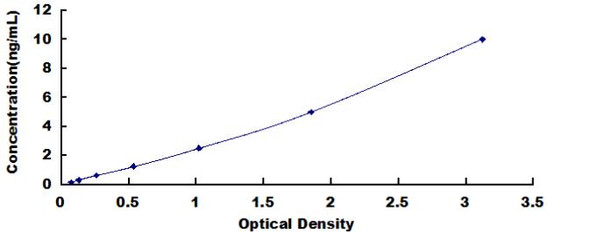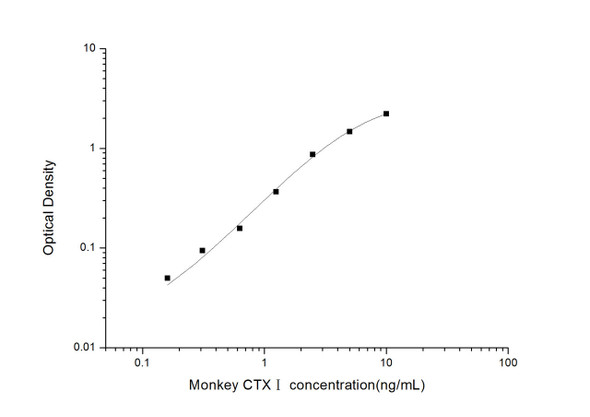Description
| Product Name: | Chicken CTXI (Cross Linked C-Telopeptide Of Type I Collagen) ELISA Kit |
| SKU: | AEKE03005 |
| Reactivity: | Chicken |
| Synonyms: | CTX-I, CTX1 |
| Assay Type: | Competitive Inhibition |
| Sensitivity: | 55.2 pg/mL |
| Standard: | 10000 pg/mL |
| Range: | 156.25-10000 pg/mL |
| Sample Type: | Serum, Plasma and Other Biological Fluids |
| Assay Length: | 2h |
| Research Area: | Metabolic Pathway; Bone Metabolism |
| Component | Quantity | Storage | |
| 48T | 96T | ||
| Pre-Coated Microplate | 6 strips × 8 wells | 12 strips × 8 wells | 4°C/−20°C |
| Standard (Lyophilized) | 1 vial | 2 vials | 4°C/−20°C |
| Biotinylated-Conjugate (100×) | 30 μL | 60 μL | 4°C/−20°C |
| Streptavidin-HRP (100×) | 60 μL | 120 μL | 4°C/−20°C |
| Standard/Sample Diluent Buffer | 10 mL | 20 mL | 4°C/−20°C |
| Biotinylated-Conjugate Diluent | 5 mL | 10 mL | 4°C/−20°C |
| HRP Diluent | 6 mL | 12 mL | 4°C/−20°C |
| Wash Buffer (25×) | 10 mL | 20 mL | 4°C/−20°C |
| TMB Substrate Solution | 6 mL | 10 mL | 4°C/−20°C (store in dark) |
| Stop Reagent | 3 mL | 6 mL | 4°C/−20°C |
| Plate Covers | 1 piece | 2 pieces | RT |
This assay utilizes a competitive inhibition enzyme immunoassay technique. The microtiter plate supplied with this kit is pre-coated with Chicken CTXI. Standards or samples are added to the designated wells, followed by the addition of a biotin-conjugated antibody specific for Chicken CTXI. Subsequently, avidin conjugated to horseradish peroxidase (HRP) is introduced and allowed to incubate. After incubation, a TMB substrate solution is added, initiating an enzyme–substrate reaction. The reaction is terminated by the addition of sulfuric acid, and the resulting colorimetric change is measured spectrophotometrically at 450 nm ± 10 nm. The concentration of Chicken CTXI in the samples is determined by comparing the optical density (OD) values of the samples to those of the standard curve.
| Standard Curve: |
|
|||||||||||||||||||||||||||
| Recovery: |
Matrices were spiked with defined levels of recombinant CTXI, and recovery was calculated by comparing measured concentrations to expected values.
|
|||||||||||||||||||||||||||
| Linearity: |
The linearity of the kit was evaluated by testing spiked samples across serial dilutions. Results are expressed as the percentage of calculated concentration relative to expected values.
|
|||||||||||||||||||||||||||
| Precision: |
Intra-assay Precision (within-run): Coefficient of variation (CV) < 8%
Inter-assay Precision (between-run): Coefficient of variation (CV) < 10% |
*Note: The following protocol serves as a general guideline. Please refer to the specific protocol provided with your kit, as procedures may vary slightly by lot.
| Step | Procedure |
| 1. | Equilibrate all kit components to room temperature before use. Add 50 μL of the Standard Working Solution (prepared by serial dilution) or 50 μL of sample to each well. Immediately add 50 μL of the 1× Biotinylated-Conjugate Working Solution to each well. Mix thoroughly and incubate the plate at 37 °C for 60 minutes. |
| 2. | Discard the liquid from the wells. Wash the wells three times with 200 μL of 1× Wash Buffer per well. After the final wash, blot the plate onto clean absorbent paper. Add 100 μL of the 1× Streptavidin–HRP Working Solution to each well and incubate at 37 °C for 60 minutes. |
| 3. | Discard the liquid from the wells. Wash the wells five times with 200 μL of 1× Wash Buffer per well. After blotting dry, add 90 μL of TMB Substrate Solution to each well and incubate at 37 °C for 20 minutes in the dark. |
| 4. | Add 50 μL of Stop Reagent to each well. Mix thoroughly by shaking the plate on a plate shaker for 1 minute. Measure the absorbance immediately at 450 nm. |
Proper sample preparation is essential for reliable and reproducible ELISA results. Below are the recommended protocols for various sample types.
| Sample Type | Preparation Protocol |
| Serum | Collect blood into a serum separator tube. Allow the samples to clot for 2 hours at room temperature or overnight at 4 °C. Centrifuge at 1000 × g for 20 minutes. Use freshly prepared serum immediately, or store aliquots at −20 °C or −80 °C for later use. Avoid repeated freeze–thaw cycles. |
| Plasma | Collect plasma using EDTA or heparin as an anticoagulant. Centrifuge at 1000 × g for 15 minutes at 2–8 °C within 30 minutes of collection. Assay immediately or store aliquots at −20 °C or −80 °C until use. Avoid repeated freeze–thaw cycles. |
| Tissue Homogenates |
Preparation may vary depending on tissue type: 1. Rinse tissues in pre-cooled PBS to remove excess blood and weigh. 2. Mince into small pieces and homogenize in fresh lysis buffer (PBS can be used for most tissues; choose buffer according to target protein localization) at a ratio of 1:9 (w:v), e.g., 900 μL lysis buffer per 100 mg tissue, using a glass homogenizer on ice. 3. Sonicate until the solution is clear. 4. Centrifuge at 10,000 × g for 5 minutes. Collect the supernatant and assay immediately or store aliquots at ≤ −20 °C. Note: It is recommended to measure protein concentration concurrently (e.g., using BCA assay, Product BC016) to normalize results per mg of protein. |
| Cell Lysates |
1. Wash adherent cells gently with pre-cooled PBS, detach with trypsin, and collect by centrifugation at 1000 × g for 5 minutes.
Suspension cells may be collected directly by centrifugation. 2. Wash the cell pellet three times with pre-cooled PBS. 3. Resuspend in lysis buffer at a density of 1 × 107 cells/mL. If necessary, sonicate until the lysate is clear. 4. Centrifuge at 1500 × g for 10 minutes at 2–8 °C. Collect the supernatant and assay immediately or store aliquots at ≤ −20 °C. |
| Urine | Collect first-morning midstream urine directly into a sterile container. Centrifuge to remove debris. Assay immediately or aliquot and store at ≤ −20 °C. Avoid repeated freeze–thaw cycles. |
| Saliva | Collect saliva using a collection device or equivalent. Centrifuge at 1000 × g for 15 minutes at 2–8 °C to remove particulates. Assay immediately or store aliquots at ≤ −20 °C. Avoid repeated freeze–thaw cycles. |
| Cell Culture Supernatants and Other Biological Fluids | Centrifuge at 1000 × g for 20 minutes. Collect the supernatant and assay immediately, or store aliquots at −20 °C or −80 °C until use. Avoid repeated freeze–thaw cycles. |






